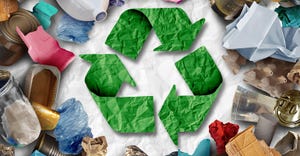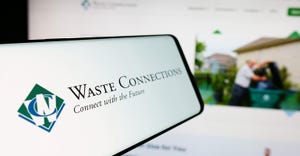California’s Recycling Market Development Program Pays Businesses to Build a Green Economy
California is enticing recycling and remanufacturing businesses to locate and expand across regions through a program that’s decades old but is ramping up and transforming. Run and funded by CalRecycle, the Recycling Market Development Zone (RMDZ) program has divvied out 219 low-interest loans totaling $206M since 1994, allocating $41.2M of it in the past three years alone as the circular economy push grows stronger.

California is enticing recycling and remanufacturing businesses to locate and expand across regions through a program that’s decades old but is ramping up and transforming.
Run and funded by CalRecycle, the Recycling Market Development Zone (RMDZ) program has divvied out 219 low-interest loans totaling $206 million since 1994, allocating $41.2 million of it in the past three years alone as the circular economy push grows stronger. It’s created over 51,000 new jobs and turned 43.8 million tons of California materials into new products.
Rachel Machi Wagoner, CalRecycle director, sat with Waste360 to explain the program’s initial concept, born even before “circular economy” was a buzz term. She comes full circle to today, telling how and why the agency is becoming more nuanced and strategic in its investment decisions.
“RMDZ was first created as an incentive to build any recycling or remanufacturing business in zones where business needs can be shown.
But now we are more discriminate, asking, what are valuable raw materials that should be recycled and remanufactured? And how do we create the infrastructure that best uses that material in the hierarchy?” she says.
Part of the evolving strategy involves looking upstream at what materials come online in the first place.
“The idea that we have not embedded both economic and environmental cost into what is manufactured [and often used only once] has created a real trash problem. We do not want to build infrastructure to encourage more undesirable, hard-to-recycle materials in the market,” Wagoner says.
With that thought, investment decisions hinge on assessments of the value of a material considering both monetary and environmental costs to determine if it’s worthwhile to recycle it.
“Those factors were not always part of the conversation … If you recycle what we need and it can have a very long lifecycle that’s something we should talk about,” she says.
Cities, counties, or regions form RMDZ’s, which are approved by CalRecycle. To qualify, jurisdictions must commit to providing resources and business incentives to complement those the agency offers.
Besides financing, benefits range from special variances in building codes and zoning laws to a more streamlined permitting process to find consistent secondary feedstock supplies.
RMDZ is really about filling the gap.
“One example I like to give when I talk about recycling infrastructure and gaps is of a company that’s turning recycled tires [crumb] into sports mats. Recycled rubber has value, and here was a company that could put it to good use [if missing supply chain links were present],” Wagoner says.
The agency thought of location, making sure the loan went not only to a processor with the technical know-how but one that could operate in that region to avoid transporting materials to a far-off facility.
Done right, economies can be built around materials management practices—or so RMDZ’s history suggests. Some research suggests the same; California could realize another $142B in economic growth by 2030 if it achieves a circular economy statewide, reports global management consulting company Accenture.
To drive innovation CalRecycle offers higher-risk loans than traditional lending facilities. But candidates have to stand up to questions like, how will you serve the circular economy? What benefit will you bring to the state and regions? And what capital improvements would you make with these funds?
In Riverside County, nine companies have received a total of $9.4M in loans through the RMDZ program for working capital, equipment, retiring onerous debt, and leasehold/capital improvements. Dozens more are tapping into the program for technical support with site selection, planning and permitting, and/or to learn of state incentive programs, among benefits.
Stephanie Stethem, economic development specialist and small business advocate, Riverside County Office of Economic Development, sums up her thoughts on the program’s real value to the county, which is the fourth largest in California and boasts the 12th largest workforce in the country.
“The program typically offers lower rates, around 4 percent with better terms, including longer payoff periods. And it’s administered by loan staff who specialize in the unique aspects of funding the circular economy,” she says.
But the greatest benefit, Stethem surmises, is the attraction and growth of recycled content product manufacturers.
“This decreases commodity prices due to the reduction in logistical costs and adds jobs to the community. It also expands the infrastructure we need statewide to meet our circular economy goals.”
Regional agencies play their part in this statewide work because they understand the landscape where they live and work, allowing them to maximize development tailored to their communities.
Historically, the City of Los Angeles primarily received inquiries from RMDZ candidate businesses and helped connect them with CalRecycle staff to access resources.
But the jurisdiction is revamping its RMDZ program and expanding its role, with plans to roll out a pilot market research and microfunding initiative.
“The market research element will aid in identifying difficulties local sustainability-focused businesses face. Determining these pain points will help us reinvigorate our RMDZ program to better focus on the needs of our local businesses,” says Alexander Brideau, senior management analyst at the City of Los Angeles.
“And the monies will allow LASAN to pilot a small, locally coordinated supplemental funding program to provide additional incentives to encourage businesses to remain in, expand in, or relocate to the City of Los Angeles,” he says.
California is now home to 39 RMDZ zones covering 88,000 square miles from the Oregon border to San Diego. Currently, $28 million is available for new loans; the monies are to target organic waste, tires, concrete, carpet, fiber, plastic, and textiles.
Meanwhile California Governor Gavin Newsom proposed in the January 2023 budget creation of a statewide zero waste plan, which Wagoner hopes will pass in the June budget.
What’s valuable for zones is it would provide a California-wide picture of the existing system, she says.
“By figuring out where the gaps are and identifying by region where improvements could be made, we can fill in the gaps for the entire state. And hopefully get an indication of what will be successful whether remanufacturing, collection, or a reuse facility. That should enable zones to target those types of business and bring more economic growth into their regions.”
About the Author
You May Also Like




